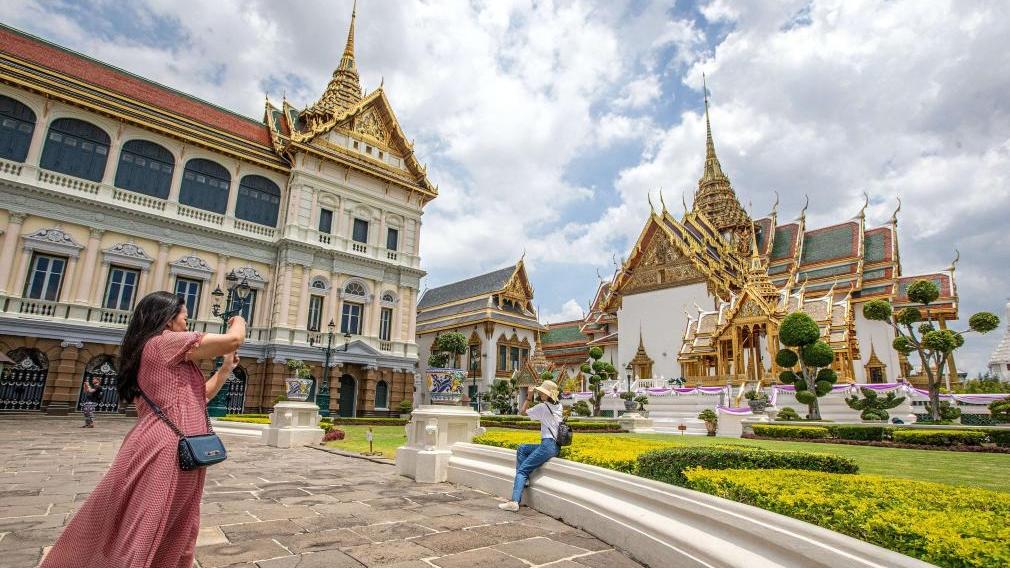 Tourists take photos at the Grand Palace scenic spot in Bangkok, Thailand, June 15, 2023. (PHOTO / XINHUA)
Tourists take photos at the Grand Palace scenic spot in Bangkok, Thailand, June 15, 2023. (PHOTO / XINHUA)
The resurgence of COVID-19 cases in Southeast Asia has not dampened resurgent tourism over the year-end holidays and ahead of the upcoming Chinese New Year festivities.
While both periods will drive an increase in visitor numbers to the region, widespread vaccination and hygiene protocols have limited the risk of getting infected, experts said.
Winston Liaw Kit Siong, chairman of the Sabah Association of Tour and Travel Agents in Malaysia, said rising COVID-19 cases have had “little effect” on tourism as people have learned to live with it
Several Southeast Asian governments, including Indonesia, Malaysia, Singapore, and Thailand have issued advisories, urging people to wear face masks and maintain good personal hygiene to curb the spread of the virus.
READ MORE: With economies on the brink, Southeast Asia chooses to reopen
Indonesia’s Health Ministry said that COVID-19 vaccines would remain free of charge for vulnerable groups starting Jan 1. Singapore’s health authorities have urged the public to “exercise personal and social responsibility” and to keep up to date with their vaccinations.
“COVID-19 is not a public health issue anymore,” said John Paolo Rivera, acting executive director at the Dr Andrew L. Tan Center for Tourism at the Asian Institute of Management (AIM), based in Makati, the Philippines.
He said while rising COVID-19 cases might discourage elderly people and those with weak immune systems from traveling, this will not deter the majority of the tourists who are vaccinated from visiting countries in the Association of Southeast Asian Nations (ASEAN).
“I do not see the resurgence of COVID-19 cases in ASEAN as a severe threat to the ASEAN travel industry but as a warning to keep mitigation measures sustainable and continuously practiced,” Rivera told China Daily.
Winston Liaw Kit Siong, chairman of the Sabah Association of Tour and Travel Agents in Malaysia, said rising COVID-19 cases have had “little effect” on tourism as people have learned to live with it.
“But people need to remain alert by wearing masks in crowded places especially like inside an elevator, a small and confined environment,” Liaw said.
I Putu Winastra, head of the Bali chapter of the Association of Indonesian Tour and Travel Agencies (ASITA), is optimistic that more foreign and local tourists will be coming to the resort island of Bali in the next few weeks to celebrate the Chinese New Year, which is known as Imlek in Indonesia.
“But we call on people to wear face masks in public places like what has repeatedly been advised by the government. We (ASITA) have always advised our members to give attention to this matter,” Winastra said.
Indonesian Tourism Minister Sandiaga Uno said in a Dec 22 press briefing that the number of foreign tourist arrivals in Indonesia in 2023 had reached 9.49 million by October — exceeding the 2023 total target of 8.5 million.
With most borders reopened in late 2022, travel and tourism stakeholders had hoped that the industry would finally recover from the damages wrought by the pandemic
He said the number would likely hit 11 million by the end of 2023, which would enable Indonesia to rake in an estimated $10.46 million in tourism receipts.
In Singapore, health authorities said the increase in COVID-19 cases could be due to several factors, including waning population immunity and increased travel and community interactions during the festive season.
Cases of JN.1, a sublineage of BA.2.86, currently account for over 60 percent of COVID-19 infections in the city-state.
In Thailand, Thira Woratanarat, a specialist in preventive medicine and epidemiology at Chulalongkorn University, said the number of COVID-19 cases has increased as people return to work after the New Year holiday, as reported by the Bangkok Post.
In Malaysia, the number of COVID-19 cases increased by over 60 percent between Dec 10 and Dec 16, but Health Minister Dzulkefly Ahmad said there was no need to impose movement restrictions for now.
With most borders reopened in late 2022, travel and tourism stakeholders had hoped that the industry would finally recover from the damages wrought by the pandemic.
READ MORE: Southeast Asia's virus surge prompts shutdowns and alarm
Rivera from the AIM said ASEAN tourism can fully recover once the pandemic has been officially declared over and resurgent cases are no longer considered a threat.
Winastra from ASITA said Indonesia and other ASEAN countries need to make special efforts to lure in more and more tourists in the coming years.
In the case of Bali and other parts of Indonesia, efforts are needed to attract visitors to stay at specially developed traditional villages. “Visitors should not only stay at hotels. They should stay in village homestays and enjoy the surrounding areas,” he said.
Leonardus Jegho is a freelance journalist for China Daily.
Contact the writers at prime@chinadailyapac.com


